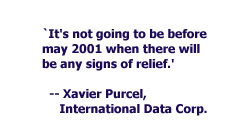|
The dash for flash memory
|
 |
May 5, 2000: 5:10 p.m. ET
Demand for mobile devices is pressuring an already tight parts supply
|
NEW YORK (CNNfn) - Accelerating demand for mobile phones and other portable electronic devices has put further pressure on an already tight supply for some of their components.
Industry observers expect that shortage to continue throughout the year, which could bode well for the suppliers of these parts, an analyst said Friday.
Eric Rothdeutsch, a semiconductor analyst at Merrill Lynch, said that makers of flash memory chips will continue to see very tight supply constraints for the next 12 to 18 months and are poised for substantial revenue acceleration.
"Demand continues to far outstrip the available supply," Rothdeutsch said. "This continues to be a significant endorsement of the flash memory manufacturers."
Unlike the memory that is used in personal computers, which is erased when the machine is powered down, flash memory holds its data even when the devices it is used in are powered down. That makes it ideal for use in portable communications and computing devices, which have grown tremendously in popularity recently.
 As evidence of a looming price boost among flash memory makers, Rothdeutsch pointed to Sharp Corp., the world's fourth-largest flash memory supplier in 1999, which recently raised prices on its flash memory products by 30 percent. As evidence of a looming price boost among flash memory makers, Rothdeutsch pointed to Sharp Corp., the world's fourth-largest flash memory supplier in 1999, which recently raised prices on its flash memory products by 30 percent.
"Flash prices have been rising throughout the second half of 1999 and into this year," he said. "But we view this as a substantial price increase, and it really indicates that there is no sign of supply coming into balance with demand."
Other companies that could benefit from a price increase include: Atmel (ATML: Research, Estimates); Intel (INTC: Research, Estimates); Advanced Micro Devices (AMD: Research, Estimates); and ST Microelectronics (AMD: Research, Estimates), Rothdeutsch said.
All of these companies have announced plans to boost their manufacturing capacity. But those efforts will not begin to ease the supply crunch for some time, said Xavier Purcel, an analyst with technology research firm International Data Corp.
"It will be up and running by the end of the year and early next year," Purcel said. "But you have to give another four to six months before it's really operational. It's not going to be before May 2001, when there will be any signs of relief."
Price increases expected
Some industry executives said it could take even longer before the industry is able to bring supply into parity with demand.
"While unit demand is going up at roughly 50 percent, the bit demand, meaning the number of wafers we have to make, is going up at about 100 percent," said Jeff Katz, vice president of marketing at Atmel. "I believe that's going to keep the shortage going at least through this year, and well into next year - possibly through all of next year."
Katz pointed out that most of the company's larger customers have entered into long-term contracts under which they are guaranteed a supply of flash memory over a fixed period of time. And that has put Atmel's focus more on adding capacity than raising prices, he said.
"We do accept higher prices, but we don't try to auction the products off," he said. "We're most concerned with increasing capacity. We're more or less satisfied with pricing the way it is now."
However, as the flash memory makers continue to increase the supply of chips in the market, Merrill's Rothdeutsch said he expects the scenario to change.
"Once capacity is added and the companies are able to produce more products, we will see a second wave of revenue accelerations moving into next year," he said.
Many of the flash memory manufacturers had been reluctant to raise prices dramatically as the supply continued to tighten because they have large customers such as Nokia (NOK: Research, Estimates), Ericsson (ERICY: Research, Estimates) and Motorola (MOT: Research, Estimates), Rothdeutsch said.
"It's always difficult to raise prices to your biggest customers, so they've had modest price increases up until now," he said. "But I think that's behind us now, and we're going to start to see substantial price increases." 
|
|
|
|
|
 |

|

